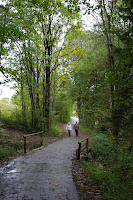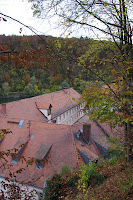Autumn is the best time for rambles in the countryside. There is no shortage of choices around Munich, from relaxing strolls to really challenging hikes.
秋天正是郊遊的好時候,慕尼黑附近郊野選擇甚多,由輕鬆到困難重重的都有。
My Hong Kong friend in Switzerland came to Munich for a weekend of catching up. After a big feast at the Oktoberfest and another friend’s place, we decided that the next day (26th September) would be a good day to take it easy. One of us suggested going for a ramble around the Schliersee lake, so we took the train to a village nearby and made our way through the fields and along the railway tracks to the Schliersee village.
我在瑞士的香港朋友到慕尼黑舊地重遊,到過啤酒節,然後還和其他朋友飽餐一頓,翌日(9月26日)當然得好好消化,所以其中一個朋友提議到慕尼黑附近的一個湖Schliersee,輕輕鬆鬆地遠足。我們坐火車到該湖附近的一條農村,穿過農田,再沿着火車軌,走到以該湖為名的小村。


Village life 農村生活


On a different track 不同道


The village of Schliersee Schliersee村
That day was pretty chilly, and we were struck by a tree that had gone completely yellow by the lake. It was a reminder that autumn has been lurking for a while behind the veil of warmer days earlier in the week, when I could still wear the traditional leather shorts to the Oktoberfest.
那天天氣微寒,我們在湖邊驀然發現一棵樹已徹底轉黃,前幾天還是很和暖,去啤酒節還可穿傳統的皮短褲,但那棵樹正好提醒我們,秋天其實已一直在悄悄等待了。



Autumn by the lake
湖畔的秋色
 The signs of autumn were more conspicuous a week later (3rd October) when I went hiking with a friend in Lenggries. My friend decided to join a Facebook group which goes for regular hikes near Munich and has roped me in for hiking in the mountains near Lenggries with them.
The signs of autumn were more conspicuous a week later (3rd October) when I went hiking with a friend in Lenggries. My friend decided to join a Facebook group which goes for regular hikes near Munich and has roped me in for hiking in the mountains near Lenggries with them.
一星期後(10月3日)跟另一個朋友到Lenggries遠足時,秋天的景緻更顯而易見。朋友在Facebook找到一班定期在慕尼黑附近遠足的小組,約我跟他們一塊兒登上Lenggries附近的高山。
Although she thought that the track should not be too difficult based on the information she got, we found not long into the hike that we had seriously underestimated the challenge ahead! The start of the track got gradually steeper, and because of the rain a couple of days earlier, the mud and rocks were still slippery. For the two of us who are not regular and serious hikers, it was indeed very onerous to negotiate through this tricky terrain and take care not to slip all the time. 看他們的資料,說路途不應太困難,但行程開始了沒多久我們才知道自己嚴重低估山路有多艱難,路徑不祇陡,而且因為早兩天才下過雨,不論是泥或是石都仍然濕滑,步步為營之餘還得當心滑倒,對我倆不常遠足的人來說簡直是畏途!


Physical and mental challenges ahead! 令身心皆受考驗的遠足路徑!
I had wanted to take photos regularly during the hike, but I decided against it and instead to put it in my backpack for a big part of the trip in order to protect this brand new camera. As we were panting and pausing frequently on the way uphill then navigating our way carefully downhill, we were stunned to see groups of elderly people who were flying past us on their walking poles. Their agility has totally disguised their real age and put us younger people to shame!
我本想邊走邊拍照,但為了保護新買的相機,還是把它放在背包好了,免得相機有何損傷。正當我們氣喘如牛地緩緩上山,又小心翼翼地下山,三五成群的退休長者拿着行山杖健步如飛的在我們身邊擦過,看他們如此矯健,真不像上了年紀,叫我倆自慚不如。


But of course I couldn't resist photo opportunities whenever we had a break!
當然有機會停下來歇息時我不會方過拍攝的時機!

These trees with bent branches were also worth a photo shot.
這些樹榦彎曲的樹也當然值得一拍。
Another uphill section awaited, but then the track were drier and less treacherous and it was time to enjoy the views of the beautiful autumnal woods. The colours of the trees were particularly striking under the brilliant sun and showed us the prettiest side of early autumn. The end of this uphill track was a hut where I finally had a chance to relax properly, a good chat with others in the group and a hearty venison goulash which was a just reward for the hard yards. But the sky started to turn dark shortly afterwards and we still had to go downhill to catch the train back to Munich. It was a race against time to go through the woods, and once outside we relied on the star light to guide us along an open path back to the town of Lenggries. Such was a strenuous day, and my thighs were still feeling the effects a couple of days on!
下山後再得上山,幸好那段路沒之前那麼濕和崎嶇,可放心邊走邊欣賞那剛剛轉黃的樹林,在陽光照射下份外鮮豔,展現出秋天迷人的一面,然後在山頂的旅舍,跟同行遠足的人邊聊邊喝,又嚐過鹿肉稠湯配麫條,之前如何辛苦驚險都補償了,不過食醉飲飽後,天色漸暗,我們得與時間競賽,趁還有陽光時穿過一個樹林,然後繼續摸黑下山,沿着開揚的路徑,依靠點點繁星,走路回到Lenggries坐火車回慕尼黑,就這樣勞役了一整天,而大腿過了兩、三天還在酸痛呢!


A more enjoyable part of the hike
終於有心情欣賞沿途風景了!


The mountains near the hut (left) and the view from the hut (right)
山頂旅舍附近的山(左)和旅舍望出去的景色(右)
After the hike in Lenggries, I worked for 19 days straight and got thoroughly sick of it since I was basically working and living at the same place. On my day off I only wanted to run away for a change of scene, and when my friend in Ingolstadt asked me if I wanted to visit her there the next day (24th October), I didn’t think twice and agreed.
那次遠足後一連工作了19天,由於工作和住宿都是在研究所,到了不用工作的那一天,我實在太厭倦了,想盡方法要逃離,轉換環境,剛好住在Ingolstadt的澳洲朋友問我翌日(10月24日)有沒有興趣到Ingolstadt一遊,我一口答應了。
En route we passed by big stretches of woods with a variegation of bright red, brown, golden yellow and green, which would have been more striking had there been some sunshine. We stopped by a site of Roman ruins and admired at the building foundations that were still standing after two thousand years. We wondered how the Romans could build something so solid that it would last such a long time. (I feel so lucky that it was actually my second time visiting Roman ruins during this European trip, having been to those in Kaiseraugst near Basel before arriving in Germany.)
沿途經過大片樹林,色彩繽紛,鮮紅色、咖啡色、金黃色和綠色交雜在一起,祇是欠陽光的襯托,不然則更美。中途我們在一處古羅馬廢墟停下來參觀昔日建築物留下來的地基,不其然感嘆當時建築技術的精良,起碼地基也可抵住二千多年的風雨留給後人。(我來到慕尼黑前在瑞士巴塞爾附近的Kaiseraugst也有參觀古羅馬廢墟,有空再補記。一次歐洲之旅能到兩個國家的古羅馬村落遺跡,實屬難得。)


The remains of the Abusina fortress Abusina堡壘的遺址
The highlight of Weltenburg is its monastery which has been brewing beer since 1050 and is the oldest monastery brewery in the world. Of course I took the opportunity to taste the most famous beer of the monastery and bought a 5-litre keg back to my institute to share it with my colleagues. I was puzzled why monasteries would get into the business of brewing, and one of my colleagues said that it was a means for the church to provide some necessities to and make some money from the cities that it ruled in the past.
Weltenburg的最大賣點是修道院,其釀酒廠原來由1050年起已釀製啤酒,是世上歷史最悠久的修道院釀酒廠,我當然不忘品嘗該酒廠最有名的啤酒,也買了一罎5公升啤酒帶回研究所與同事分甘同味。後來跟同事討論,為甚麼修道院也會從事釀酒,有人便說,歷史上不少城市由教會統治,教會為了開拓財源和提供市民所需,都會經營這些業務。


Views of the Danube river that runs past Weltenburg
Weltenburg那一段多瑙河的景色


The monastery (left) and the church (right)
修道院(左)和教堂(右)

Inside the church
教堂內部
There were many more memorable sights in other countries outside Germany, and I’ll slowly start to fill you in.
除了德國,其他國家也有很多令人難忘的景緻,有空讓我再慢慢寫吧。
秋天正是郊遊的好時候,慕尼黑附近郊野選擇甚多,由輕鬆到困難重重的都有。
My Hong Kong friend in Switzerland came to Munich for a weekend of catching up. After a big feast at the Oktoberfest and another friend’s place, we decided that the next day (26th September) would be a good day to take it easy. One of us suggested going for a ramble around the Schliersee lake, so we took the train to a village nearby and made our way through the fields and along the railway tracks to the Schliersee village.
我在瑞士的香港朋友到慕尼黑舊地重遊,到過啤酒節,然後還和其他朋友飽餐一頓,翌日(9月26日)當然得好好消化,所以其中一個朋友提議到慕尼黑附近的一個湖Schliersee,輕輕鬆鬆地遠足。我們坐火車到該湖附近的一條農村,穿過農田,再沿着火車軌,走到以該湖為名的小村。


Village life 農村生活


On a different track 不同道


The village of Schliersee Schliersee村
That day was pretty chilly, and we were struck by a tree that had gone completely yellow by the lake. It was a reminder that autumn has been lurking for a while behind the veil of warmer days earlier in the week, when I could still wear the traditional leather shorts to the Oktoberfest.
那天天氣微寒,我們在湖邊驀然發現一棵樹已徹底轉黃,前幾天還是很和暖,去啤酒節還可穿傳統的皮短褲,但那棵樹正好提醒我們,秋天其實已一直在悄悄等待了。



Autumn by the lake
湖畔的秋色
 The signs of autumn were more conspicuous a week later (3rd October) when I went hiking with a friend in Lenggries. My friend decided to join a Facebook group which goes for regular hikes near Munich and has roped me in for hiking in the mountains near Lenggries with them.
The signs of autumn were more conspicuous a week later (3rd October) when I went hiking with a friend in Lenggries. My friend decided to join a Facebook group which goes for regular hikes near Munich and has roped me in for hiking in the mountains near Lenggries with them.一星期後(10月3日)跟另一個朋友到Lenggries遠足時,秋天的景緻更顯而易見。朋友在Facebook找到一班定期在慕尼黑附近遠足的小組,約我跟他們一塊兒登上Lenggries附近的高山。
Although she thought that the track should not be too difficult based on the information she got, we found not long into the hike that we had seriously underestimated the challenge ahead! The start of the track got gradually steeper, and because of the rain a couple of days earlier, the mud and rocks were still slippery. For the two of us who are not regular and serious hikers, it was indeed very onerous to negotiate through this tricky terrain and take care not to slip all the time. 看他們的資料,說路途不應太困難,但行程開始了沒多久我們才知道自己嚴重低估山路有多艱難,路徑不祇陡,而且因為早兩天才下過雨,不論是泥或是石都仍然濕滑,步步為營之餘還得當心滑倒,對我倆不常遠足的人來說簡直是畏途!


Physical and mental challenges ahead! 令身心皆受考驗的遠足路徑!
I had wanted to take photos regularly during the hike, but I decided against it and instead to put it in my backpack for a big part of the trip in order to protect this brand new camera. As we were panting and pausing frequently on the way uphill then navigating our way carefully downhill, we were stunned to see groups of elderly people who were flying past us on their walking poles. Their agility has totally disguised their real age and put us younger people to shame!
我本想邊走邊拍照,但為了保護新買的相機,還是把它放在背包好了,免得相機有何損傷。正當我們氣喘如牛地緩緩上山,又小心翼翼地下山,三五成群的退休長者拿着行山杖健步如飛的在我們身邊擦過,看他們如此矯健,真不像上了年紀,叫我倆自慚不如。


But of course I couldn't resist photo opportunities whenever we had a break!
當然有機會停下來歇息時我不會方過拍攝的時機!

These trees with bent branches were also worth a photo shot.
這些樹榦彎曲的樹也當然值得一拍。
Another uphill section awaited, but then the track were drier and less treacherous and it was time to enjoy the views of the beautiful autumnal woods. The colours of the trees were particularly striking under the brilliant sun and showed us the prettiest side of early autumn. The end of this uphill track was a hut where I finally had a chance to relax properly, a good chat with others in the group and a hearty venison goulash which was a just reward for the hard yards. But the sky started to turn dark shortly afterwards and we still had to go downhill to catch the train back to Munich. It was a race against time to go through the woods, and once outside we relied on the star light to guide us along an open path back to the town of Lenggries. Such was a strenuous day, and my thighs were still feeling the effects a couple of days on!
下山後再得上山,幸好那段路沒之前那麼濕和崎嶇,可放心邊走邊欣賞那剛剛轉黃的樹林,在陽光照射下份外鮮豔,展現出秋天迷人的一面,然後在山頂的旅舍,跟同行遠足的人邊聊邊喝,又嚐過鹿肉稠湯配麫條,之前如何辛苦驚險都補償了,不過食醉飲飽後,天色漸暗,我們得與時間競賽,趁還有陽光時穿過一個樹林,然後繼續摸黑下山,沿着開揚的路徑,依靠點點繁星,走路回到Lenggries坐火車回慕尼黑,就這樣勞役了一整天,而大腿過了兩、三天還在酸痛呢!


A more enjoyable part of the hike
終於有心情欣賞沿途風景了!


The mountains near the hut (left) and the view from the hut (right)
山頂旅舍附近的山(左)和旅舍望出去的景色(右)
After the hike in Lenggries, I worked for 19 days straight and got thoroughly sick of it since I was basically working and living at the same place. On my day off I only wanted to run away for a change of scene, and when my friend in Ingolstadt asked me if I wanted to visit her there the next day (24th October), I didn’t think twice and agreed.
那次遠足後一連工作了19天,由於工作和住宿都是在研究所,到了不用工作的那一天,我實在太厭倦了,想盡方法要逃離,轉換環境,剛好住在Ingolstadt的澳洲朋友問我翌日(10月24日)有沒有興趣到Ingolstadt一遊,我一口答應了。
En route we passed by big stretches of woods with a variegation of bright red, brown, golden yellow and green, which would have been more striking had there been some sunshine. We stopped by a site of Roman ruins and admired at the building foundations that were still standing after two thousand years. We wondered how the Romans could build something so solid that it would last such a long time. (I feel so lucky that it was actually my second time visiting Roman ruins during this European trip, having been to those in Kaiseraugst near Basel before arriving in Germany.)
沿途經過大片樹林,色彩繽紛,鮮紅色、咖啡色、金黃色和綠色交雜在一起,祇是欠陽光的襯托,不然則更美。中途我們在一處古羅馬廢墟停下來參觀昔日建築物留下來的地基,不其然感嘆當時建築技術的精良,起碼地基也可抵住二千多年的風雨留給後人。(我來到慕尼黑前在瑞士巴塞爾附近的Kaiseraugst也有參觀古羅馬廢墟,有空再補記。一次歐洲之旅能到兩個國家的古羅馬村落遺跡,實屬難得。)


The remains of the Abusina fortress Abusina堡壘的遺址
The highlight of Weltenburg is its monastery which has been brewing beer since 1050 and is the oldest monastery brewery in the world. Of course I took the opportunity to taste the most famous beer of the monastery and bought a 5-litre keg back to my institute to share it with my colleagues. I was puzzled why monasteries would get into the business of brewing, and one of my colleagues said that it was a means for the church to provide some necessities to and make some money from the cities that it ruled in the past.
Weltenburg的最大賣點是修道院,其釀酒廠原來由1050年起已釀製啤酒,是世上歷史最悠久的修道院釀酒廠,我當然不忘品嘗該酒廠最有名的啤酒,也買了一罎5公升啤酒帶回研究所與同事分甘同味。後來跟同事討論,為甚麼修道院也會從事釀酒,有人便說,歷史上不少城市由教會統治,教會為了開拓財源和提供市民所需,都會經營這些業務。


Views of the Danube river that runs past Weltenburg
Weltenburg那一段多瑙河的景色


The monastery (left) and the church (right)
修道院(左)和教堂(右)

Inside the church
教堂內部
There were many more memorable sights in other countries outside Germany, and I’ll slowly start to fill you in.
除了德國,其他國家也有很多令人難忘的景緻,有空讓我再慢慢寫吧。
Comments